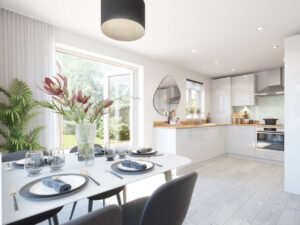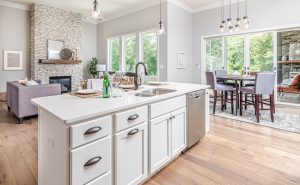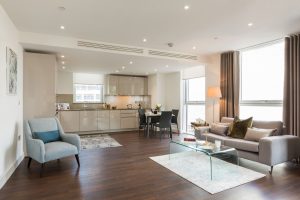It’s a design concept that’s enjoyed popularity in the UK for decades, but how is open plan living viewed now? Is it still the most sought-after residential home design setup, or is it on the way out? Find out all about this innovative approach to floorplans in our quick pros and cons roundup.
FAQs
What is open plan living?

Open plan living is a home design concept that features larger, combined common spaces by taking out partition walls. Usually, an open plan design will feature a combined kitchen/dining room, dining/living room or even a combined kitchen/dining/living room configuration.
What is the history of open plan living?
The history of open plan living really begins in the 1950s. In post-war Britain, formal entertaining was giving way to more casual gatherings. People wanted more space, more informality and more convenience.
The open plan design really took off in the mid-50s, and homes that had it were seen as especially modern. From there, it has become a regular feature in UK home design, particularly in modern apartments that want to maximise the use of space.
What can I include in an open plan living space?
If you’re considering a home extension or renovation, the layout and elements of an open plan living space are entirely up to you. Many people combine kitchen and dining rooms into one open plan area, as these are often adjoining and make a useful social living space.
You could also include a sitting area or a home working area, depending on the available space and your lifestyle preferences. As kitchens are often part of the open plan space, and they’re frequently found at the back of the house, many people also incorporate easy access to their gardens with the inclusion of French doors, bi-folds or sliding glass doors. These also welcome much more light, which can be useful if your open plan living space is particularly large or deep.

What are the benefits of open plan living?
The main benefit of open plan living is that you gain more useable space. Fewer walls mean bigger rooms that are more suitable for larger gatherings. Most people want an open plan living layout if they plan to entertain frequently, since their guests will feel more included and less enclosed.
Another key advantage is that rooms can be multifunctional. The combined, open plan rooms become the focus of the activity for everyone living in the home. Parents can more easily watch over their children and stay engaged with them even as they tidy up, cook or clean.
As well as being great for entertaining and bringing the family together, open plan living also makes the home lighter and brighter. The lack of partition walls means that light can reach right into the common spaces more easily.
What are the disadvantages of open plan living?
The main drawback of open plan living is that you sacrifice privacy for space. Without walls, the rooms don’t serve a dedicated function anymore. There’s also nothing to block noises and smells.
This will doubtless be an issue for millions of people who have transitioned to home working or hybrid working since the pandemic. If everyone in the family is in the same room, it’s much easier to become distracted by the resultant noise and activity.
Then, of course, there’s the issue of heating.

Are open plan houses colder?
Having an open plan living design means that your combined room(s) will be harder and more expensive to heat. This is because you will need to heat up the whole, larger space.
With the UK having recently come through one of the worse energy price crisis in generations, this is something worth thinking about.
Does open plan living add value?
Changing your home to an open plan living design will not necessarily add value to it. This is because open plan living is a design concept that is a matter of personal taste. Some buyers love it, some hate it, and others don’t mind one way or the other. As with many elements of home design, open plan living can become more, or less, fashionable as tastes change and new trends emerge.
However, there is research that suggests that open plan living can add value to your property. A recent study showed that converting to an open plan can provide a value bump of as much as 15%. This is provided that the conversion is done well and is sympathetic to the overall design of the home.
What are the most important considerations for making an open plan living layout?
To make the most of an open plan living layout, consider the following:

Heating: Make sure you have a solid plan to keep the open plan areas warm. You don’t want to rely on a hearth fire or space heaters entirely; you need a comprehensive heating solution. Having high-quality double or even triple glazing is a must.
Create viable zones: You don’t want the area to become ‘broken plan’ rather than ‘open plan’. Ensure that the area is split into separate areas through the sensible placing of furniture and potentially using partial ‘chest-high’ walls.
Sensible lighting: Remember that you have a much bigger area to light, and that your electric light will carry further since there are no walls. During the day, open plan living areas receive more natural light, but for dark days and evenings you’ll want a well-planned lighting setup.
Consider combining open plan space with more private rooms: Many homes now benefit from a mixture of open-plan living and more compartmented, private living spaces. Consider whether you can open up some of the space in your home while still providing a degree of private space, either for home working or relaxing in peace.
Is open plan living still fashionable?
Open plan living is still very fashionable in the UK. Post-pandemic, there is a lot more emphasis now on having a good outdoor spaces but also enough space to entertain family and friends comfortably inside. This is what makes open plan living so sought after.

Is open plan living a good idea?
Open plan living can be a good idea if you’re looking to make the most of the space you have. If you live in a smaller property, open plan design can give you the space to breathe and enjoy your home to the fullest.
However, keep in mind the drawbacks to this design approach. The lack of privacy and higher heating costs aren’t trivial, and should be considered before you commit to open plan living.
Where can you find open plan living properties in the UK?
Open plan living properties can be found throughout the UK. The popularity of this style of interior design is on the rise, so you’ll find all manner of homes converting to include it, as well as new-build properties that embrace it.
Although they are available in practically every city, town and most villages, you’ll find much greater concentrations of open plan homes in bigger cities and towns that rely on tourism. Big cities come with a lot of apartment buildings, and maximising useable space is a high priority for flats. Similarly, tourist towns want their rental properties to be light, airy and inviting, which favours an open plan interior design approach.
Good design can make all the difference to a home’s value. Find out how in our exploration of the importance of design in new-build properties below. Also, for a London-specific example, see how good design can tack on as much as 11% premium to London homes.
Read more
HomeViews is the only independent review platform for residential developments in the UK. Prospective buyers and tenants use it to make an informed decision on where to live based on insights from carefully verified resident reviews. Part of Rightmove since February 2024, we’re working with developers, house builders, operators, housing associations and the Government to give residents a voice, recognise high performers and to help improve standards across the industry.



















